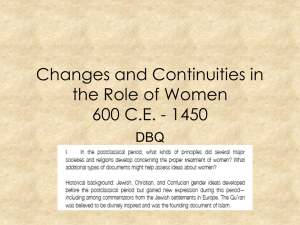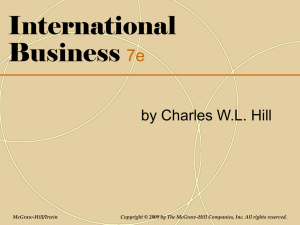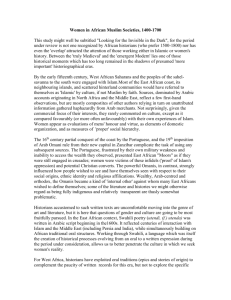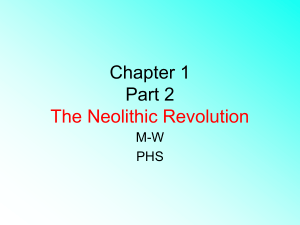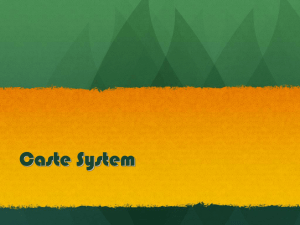600-1450 Women Status
advertisement
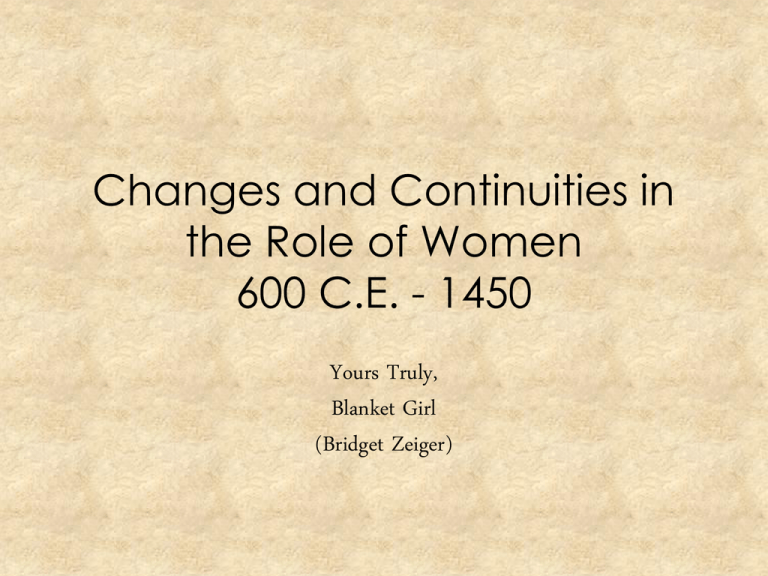
Changes and Continuities in the Role of Women 600 C.E. - 1450 Yours Truly, Blanket Girl (Bridget Zeiger) What’s Happening? • During this time period, • Islam is spreading • Christianity and Buddhism are opened to new regions • New empires are developed, based on wealth and acquisition of property • Revitalization of neo-Confucianism • These features impacted women’s role in each society. In general, • Restrictions on women’s freedoms depended on which caste or class they belonged to. • In some regions, women at the highest levels could overcome their status and assume leadership roles if a male heir was not capable. • Generally, however, as societies became more urban and wealthy, women (especially in the elite and upper class) had their freedoms further restricted, even if their status arose. i.e. » Increased veiling in Islamic world » Foot-binding in neo-Confucian China » Young marriage in South Asia Some Benefits? • Access to more education, especially in China and Japan. • However, overall, women were usually far less powerful than their male counterparts and had many restrictions. Five Major Regions… • Considering the APWH exam is going to be asking on a broad spectrum, here are the five major regions one could focus on… Europe Islam Africa India China Europe • • • • • • • There were strict patriarchal and social divisions. Women could inherit land. Women could bring a court case but could not participate in the sentence. Women usually worked in textiles; they were divided in labor. Christian Monogamy (1 partner) increased. Education is limited to the upper class males. Veiling of upper class is present. Islam • There is equality in religion but separate in mosque. • Women received half inheritance of male children. So, if father dies, women receives half of what son would have gotten. • Women’s testimonies had less influence than that of a male. • Concubines and seclusion in harems were present. • Women were exposed to education; literate society. • Veiling is public. Africa • As trade and new religions increased and arrived, role of women did not change because nomads of African societies were egalitarian. • As sedentary lifestyles developed, societies were matriarchal, where women were dominant in household. – Women demanded a bride-price. – “Mother of the King” was a political office where women held office and participated in religious rituals controlled by women. India • • • • There was a strict patriarchal caste system. Women (and men, too!) married at a very young age. Practice of ‘sati’ for widows was present. Marriage is limited to caste members (one cannot marry outside his/her class). • Education is limited. • ‘Purdah’: veiling and seclusion was popular during the time. China • Confucianism, the dominant religion, held strict guidelines for virtuous behavior. • Women have access to dowries and owned businesses. • Widow must remain with the son and could not own property if they remarried. • The main occupation of women was silk-weaving. • Concubines and seclusion in harems were current during the time. • State education is limited to men; however, women were still literate. • Foot-binding was customary.
